Nest building in the fever trees in our garden has been feverish. After what seemed like some practice runs building nests next to the palm tree used for nesting material, the Village Weavers abandoned these first efforts. They then congregated noisily each day to build nests and engage in flamboyant displays high up in the branches of the fever trees.
Watching them on and off, I found their activities somewhat confusing, but after doing a little reading I confirmed that, yes, it is the males that construct and weave the nests, but some males may start doing that before they acquire their summer breeding colours. Perhaps that explains why it appeared as if females where nest-building too?
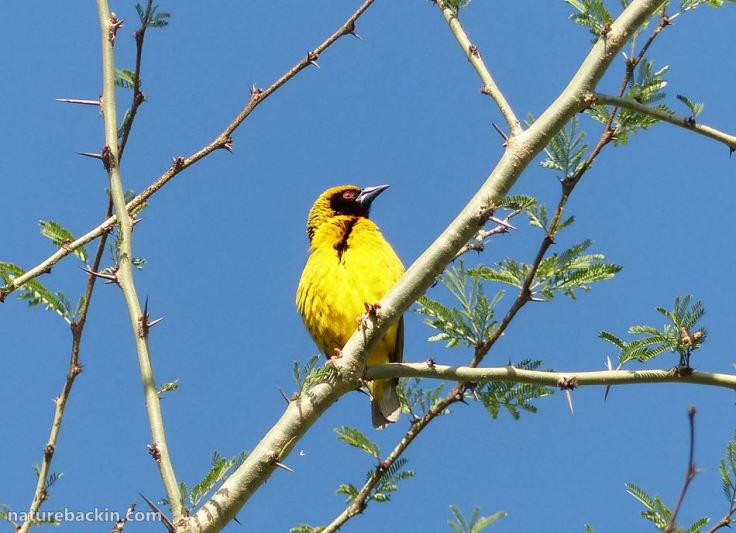
An adult male Village Weaver in his full breeding colours. When not breeding the yellow fades and he loses the black face and throat, and his colouring then resembles that of the female

These two birds appear to be males in the process of acquiring their breeding colours. The black patch on the face is becoming apparent, and feathers are brightening to yellow
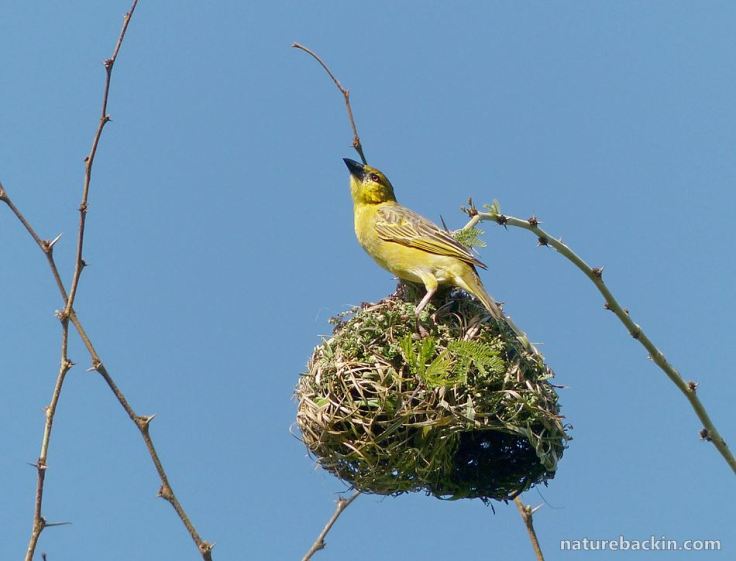
It is hard to distinguish between female Village Weavers and juvenile or non-breeding males. I took this to be a female inspecting the nest, even though the bill appears to be darker than it should be – according to many sources. As the colouring of both males and females seems to be quite variable, I can’t be absolutely certain that this is a female
Village Weavers nest in colonies, often with many nests in the same tree. As the name implies, they often nest in proximity to human habitation. The males build the nests, and defend the small ‘territory’ around the nest as they build. They may build up to five nests in a season, attracting a female to each nest.

Nests in the fever trees (Vachellia xanthophloea) silhouetted against gathering storm clouds at dusk
Building nests is an arduous and time-consuming process. Not only is securing and weaving the nest difficult, requiring a fair degree of athletic flexibility and concentration, it also requires frequent flights back and forth to gather weaving material. In our garden, the Wild Date Palm (Phoenix reclinata) is heavily used by the weavers tearing off strips of palm leaf to use for their nests.

By the end of the nest-building season, our palm tree starts looking rather frayed, but the old leaves are soon replaced by new growth
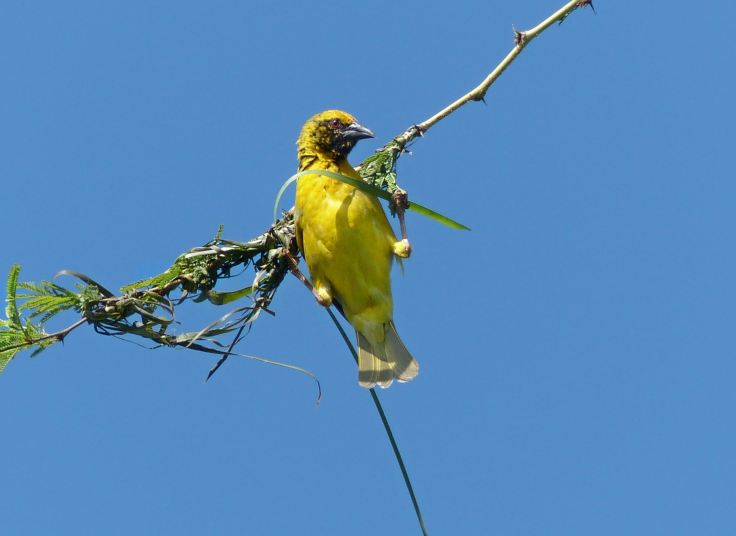
Starting a nest appears to be quite tricky

It requires dexterity and persistence

The bill and the feet are used in the process of securing strips of leaf to anchor them to the branch, and when weaving and knotting the leaves to form the nest

Even in the early stages of making a nest, building it is interrupted by vigorous bouts of displaying – usually dangling upside down with tail spread and fluttering the wings, all the while with most birds in the colony making their characteristic ‘swizzling’ song

Once the beginnings of the nest are securely anchored, the circular diameter of the nest is shaped
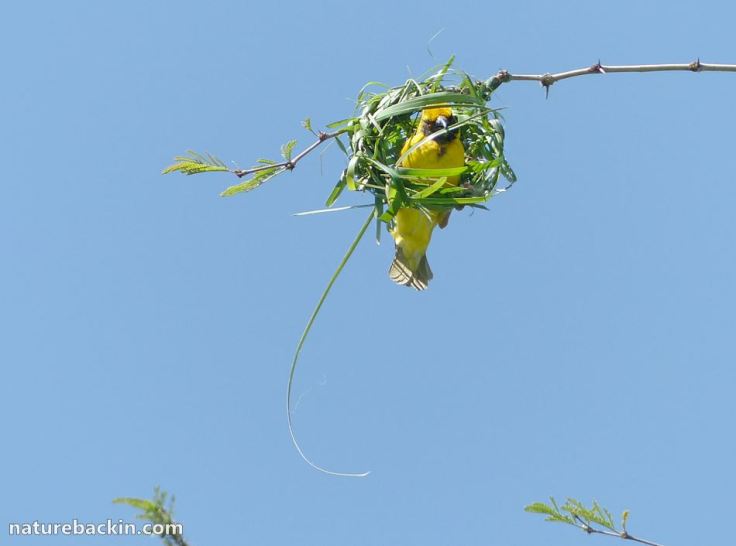
Once the ring is made, the nest chamber is made. The split ends of leaves are woven in different directions. Each nest takes 9 to 15 hours to build

This nest is taking shape
Studies have shown that the nest walls are woven from hundreds of strips of leaf material (average 384 leaves) with each piece being 250 to 300 mm long. The roof is thatched and lined with many more leaves forming a roof and ceiling. The entrance to the nest is always underneath. Sometimes a very short spout is added to the entrance.

This male is fluttering his wings furiously as he displays at his nearly completed nest
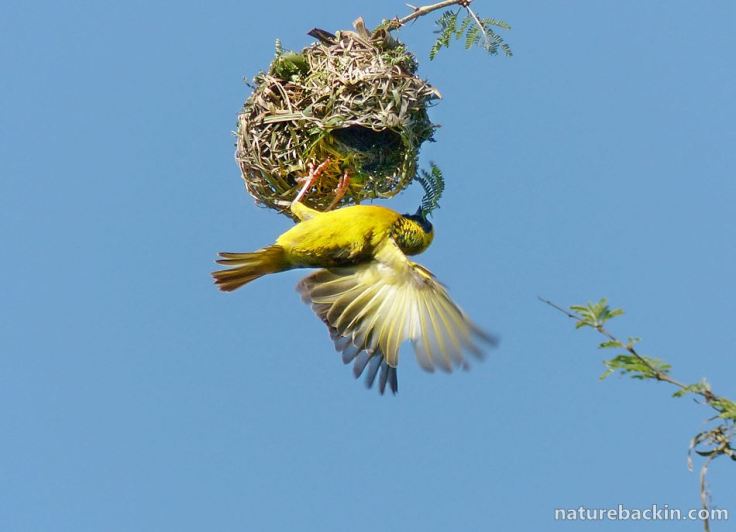
Displaying upside down under the nest while swinging the body from side to side and fluttering the wings is a favourite form of display. This male weaver is displaying and calling while he has a bill full of fever tree leaves that he is using to line the roof
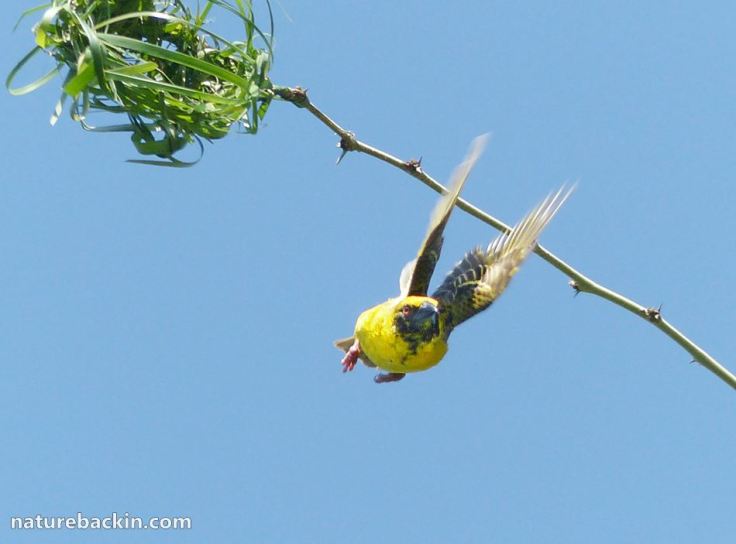
This bird is flying off to go to collect more strands of leaf for weaving into the nest
Displaying seems to be infectious. When one bird starts then all the others building their nests seem to join in. Displaying may also coincide with a female arriving to inspect a nest. Sometimes altercations break out. One morning a particularly prolonged scrap broke out between a male in full breeding plumage and one that did not yet have his full colours.

This confrontation with two birds challenging each other near a nest continued for well over two minutes. The only contact they made was pecking at each other’s bills from time to time

Much of the challenge consisted of facing-off while ‘swizzling’ loudly

Once the confrontation was over they resumed building their nests
The female inspects the nest before it is finished, and it is thought that she selects a nest on the basis of its strength. Once she has accepted the nest, the male may add a short entrance tunnel, and the female lines the cup of the nest with grass heads, small leaves and feathers. Sometimes rejected nests are demolished before the male starts working on a replacement.
The incubation period for eggs, which are incubated by the female, is about 12 days, and nestlings are in the nest for about 17 days. The young are fed mostly by the female. Strangely, in our garden, despite all the activity, we have never seen weavers using the completed nests nor raising young. This year, after about two weeks of nest building in other trees and then about another two weeks of great activity in the fever trees, the birds have moved on, and the nests appear to be deserted. Although nests are built every year we have never noticed them being used. It is possible that they are used, but if so, so discreetly we never see it.

This weaver, likely a female, is carrying a sprig of leaves to the nest
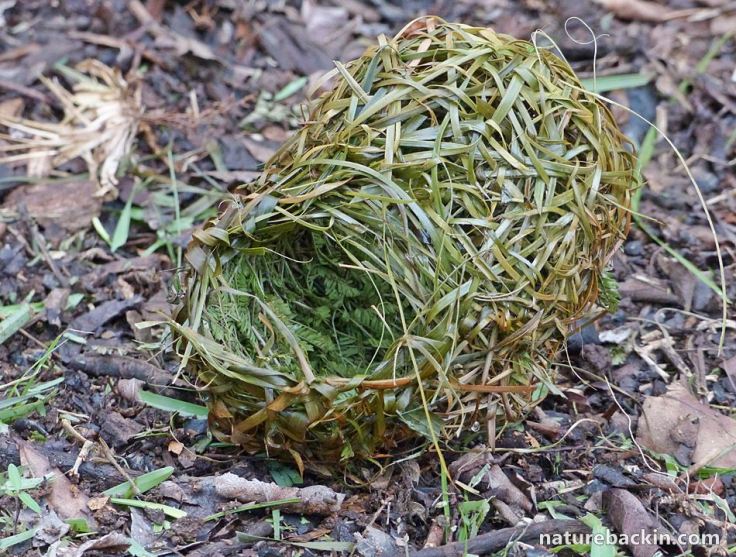
This nest was discarded and fell to the ground beneath the nesting tree. It is upside down, and that the roof is carefully lined with sprigs of leaves from the fever trees can be seen clearly

Finishing touches to the roof
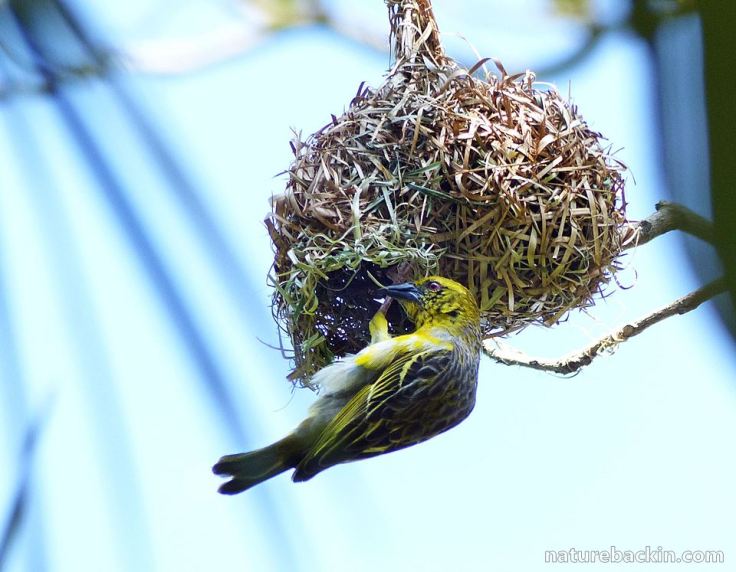
Neatening up the entrance. This nest was built low down near the palm tree. It was soon abandoned and not used despite being completed

After all the activity and hard work, it is strange that the weavers moved on so soon. The garden is strangely quiet without their incessant swizzling song

Source: Roberts VII Multimedia PC Edition. 1997-2016 Southern African Birding. For details go to http://www.sabirding.co.za/roberts7/portal.html
Posted by Carol









December 22, 2017 at 3:09 pm
Absolutely stunning.
LikeLiked by 1 person
December 22, 2017 at 7:44 pm
Thanks!
LikeLiked by 1 person
December 22, 2017 at 4:43 am
Beautifully captured in the detail. The stages of nest building and their dexterity are amazing. Enjoyed the post and your descriptions.
LikeLiked by 1 person
December 22, 2017 at 5:24 am
Thanks very much Liz. I am looking forward to browsing through your posts on Namibia. Sorry I have not been able to do that yet.
LikeLike
December 15, 2017 at 2:06 pm
Lovely series of nest building.
LikeLiked by 1 person
December 16, 2017 at 9:29 pm
Thank you Sherry.
LikeLike
December 15, 2017 at 10:45 am
Amazing photos. What feats of engineering and dexterity from these little birds.
LikeLiked by 1 person
December 16, 2017 at 9:28 pm
Thanks Sandra. It is surprising how strong the nests are and the builders are amazingly dextrous even without fingers and thumbs!
LikeLiked by 1 person
December 15, 2017 at 9:02 am
Ah! This is a sight I have missed, and so beautifully documented by your photos, Carol – the whole fiddly process of weaver nest building. I used to spend hours watching them in the papyrus clumps at Hunters Lodge.
LikeLiked by 1 person
December 16, 2017 at 9:25 pm
Thanks Tish. ‘Fiddly process’ is a good way to describe it.
LikeLiked by 1 person
December 15, 2017 at 9:00 am
We usually only get the Southern Masked Weaver at our spot and until our neighbour unceremoniously chopped down a large tree in his garden it was a joy to watch them go about building their nests.
I think your bird is a female. Her whole stance suggests she is contemplating a serious decor change, including educational toys for the upcoming hatchlings. 🙂
LikeLiked by 1 person
December 16, 2017 at 9:23 pm
Sad when a tree gets chopped down for no good reason.
The weaver does seem to take her role as nest inspector most seriously ☺
LikeLike
December 15, 2017 at 7:51 am
I learn so much from your captivating pictures and informed prose. Thank you so much!
LikeLiked by 1 person
December 16, 2017 at 9:17 pm
Thanks for your kind comment ☺
LikeLiked by 1 person
December 15, 2017 at 3:46 am
A great ‘nestorial’! We also find that most of the nests built in our garden with great flourish are abandoned without being used for breeding.
LikeLiked by 1 person
December 16, 2017 at 9:13 pm
That is interesting that nests are abandoned at your place too. I am still wondering why they build so many nests each year only to move on without using them.
LikeLike
December 15, 2017 at 2:48 am
I don’t think I have ever come across a more interesting post with so many amazing pictures. Thank you for sharing this.
LikeLiked by 1 person
December 16, 2017 at 9:03 pm
Thank you for the lovely comment ☺
LikeLiked by 1 person
December 15, 2017 at 12:06 am
That has to be one of the most beautiful nests I have ever seen. Thanks so much for taking the time to show and explain it to us.
LikeLiked by 1 person
December 16, 2017 at 9:00 pm
Thank you. It was a pleasure to share ☺
LikeLiked by 1 person
December 14, 2017 at 9:54 pm
An incredible display to witness and then document! And beautiful photographs too!
LikeLiked by 1 person
December 14, 2017 at 9:22 pm
I can’t think how you ever get out of your garden. There’s so much going on. A wonderful account.
LikeLiked by 1 person
December 16, 2017 at 8:48 pm
Thanks Margaret. I think the more I look the more I see ☺
LikeLike
December 14, 2017 at 9:17 pm
What a fascinating species. It is strange that after all that effort the nests are not used!
LikeLiked by 1 person
December 16, 2017 at 8:47 pm
Yes they are endlessly fascinating. I wish I knew why they don’t use their nests …
LikeLiked by 1 person
December 14, 2017 at 9:07 pm
Loved your post! Those are amazing birds. The strongly resemble our Goldfinches here in North Carolina.
Dwight
LikeLiked by 1 person
December 16, 2017 at 8:44 pm
Thank you so much Dwight. I will be looking up your Goldfinches.
LikeLiked by 1 person
December 14, 2017 at 8:47 pm
Wow. Lots of lovely photos and very interesting, too.
LikeLiked by 1 person
December 16, 2017 at 8:34 pm
Thanks Graham.
LikeLike
December 14, 2017 at 8:20 pm
True artists at work!
LikeLike
December 16, 2017 at 8:31 pm
There is a kind of artistry to these beautiful nests.
LikeLiked by 1 person
December 14, 2017 at 8:20 pm
Thanks for this wonderful story of these birds’ nesting behaviour and building activity, and for the wonderful photos. I enjoyed this so much, and their nests are just incredible!
LikeLiked by 1 person
December 16, 2017 at 8:29 pm
Thanks so much. I enjoyed sharing what I have observed of these weavers and their amazing nest-building.
LikeLiked by 1 person
July 26, 2018 at 7:11 am
Hi again Carol. I’m think of putting a post together on the topic of Weaving. If I do, could I use 2 photos from this beautiful post (with clear credit to you and link to your post) please, pleeese!
LikeLiked by 1 person
July 26, 2018 at 8:26 pm
Hi Liz. Have only seen your messages now. Posting on the topic of Weaving would be very interesting, and you are welcome to use 2 photos from my post on the Weaver birds. I look forward to seeing your post.
LikeLiked by 1 person
July 26, 2018 at 8:28 pm
Wonderful, thank you!
LikeLiked by 1 person
July 27, 2018 at 9:53 pm
Really appreciate you letting me use your photos. The post is online at https://exploringcolour.wordpress.com/2018/07/28/theme-woven/
LikeLike